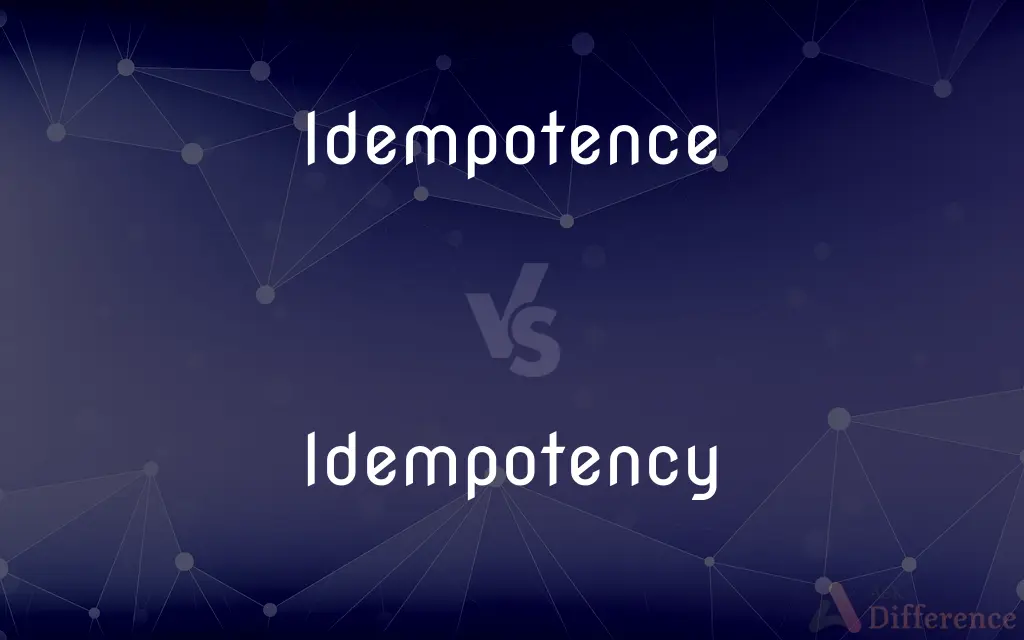Idempotence vs. Idempotency — What's the Difference?
By Maham Liaqat & Fiza Rafique — Updated on May 9, 2024
Idempotence refers to the property of certain operations in mathematics and computer science where the result remains the same no matter how many times the operation is applied; idempotency refers to the quality or state of being idempotent.

Difference Between Idempotence and Idempotency
Table of Contents
ADVERTISEMENT
Key Differences
Idempotence is a concept in mathematics and computer science that describes an operation that, when applied multiple times, has the same effect as when applied once. This principle is crucial in various applications, such as database transactions and HTTP methods. In contrast, idempotency is the noun describing the characteristic of being idempotent, focusing on the condition or quality rather than the action itself.
When discussing software design, idempotence ensures that methods or functions can be called repeatedly without causing additional changes after the first application. This is key for recovery processes and repetitive user actions. On the other hand, idempotency as a term is used more in theoretical discussions or specifications to describe or mandate this behavior in system components.
In practical applications, ensuring an operation is idempotent allows developers to design more robust systems, where the effect of an operation doesn't compound with multiple executions. Whereas discussing idempotency involves evaluating or asserting this property in existing or planned operations.
Operations like setting a value (e.g., x = 1), where repeated settings have the same effect, illustrate idempotence. Discussions about idempotency would look at how systems maintain consistency and reliability when such operations are involved.
When a system is described as having idempotent features, it refers to its ability to prevent additional changes upon repeated requests, which is a direct application of the idempotence principle. However, the term idempotency itself is often used to abstractly describe these features as aspects of system design or architecture.
ADVERTISEMENT
Comparison Chart
Definition
The property of operations that do not change the result beyond the initial application
The state or condition of being idempotent
Focus
On the operation itself
On the characteristic or quality
Usage Context
Common in practical implementation in programming and system design
More theoretical or descriptive discussions
Example Operations
X = 1, abs(-10), sort(list)
Describing the operations as idempotent
Key Importance
Ensures no side effects with multiple applications
Describes the reliability and consistency of systems
Compare with Definitions
Idempotence
The property of certain operations that can be applied multiple times without changing the result beyond the initial application.
In RESTful APIs, PUT requests are designed to be idempotent.
Idempotency
The characteristic of operations where multiple applications produce the same result as a single application.
The idempotency of the DELETE HTTP method ensures that the outcome is the same, no matter how many times it is called.
Idempotence
Used to describe operations that inherently prevent further impact after the first execution.
The delete operation in database management is typically idempotent.
Idempotency
A principle in software engineering to enhance robustness and consistency.
Ensuring idempotency in a cloud service API helps prevent data corruption during network interruptions.
Idempotence
In mathematics, a function where f(f(x)) = f(x) for all x in the domain.
The function f(x) = x^2 is idempotent over the set of 1 and 0.
Idempotency
Often used in theoretical discourse to discuss properties of algebraic structures.
Idempotency is a key topic in the study of certain algebraic groups.
Idempotence
In programming, operations or functions where the result of performing the operation once is identical to the result of performing it repeatedly.
Assigning a fixed value to a variable is an idempotent operation.
Idempotency
A quality of mathematical functions or operations in algebra.
The idempotency of a boolean AND operation, where true AND true always returns true.
Idempotence
A crucial principle in designing fault-tolerant systems.
Idempotence ensures that retry operations do not cause unwanted effects.
Idempotency
In system design, a descriptor for systems that reliably handle multiple identical requests.
Idempotency in web services design is crucial for maintaining state consistency.
Idempotence
Idempotence (UK: , US: ) is the property of certain operations in mathematics and computer science whereby they can be applied multiple times without changing the result beyond the initial application. The concept of idempotence arises in a number of places in abstract algebra (in particular, in the theory of projectors and closure operators) and functional programming (in which it is connected to the property of referential transparency).
Idempotency
Idempotence.
Idempotence
A quality of an action such that repetitions of the action have no further effect on outcome – being idempotent.
Common Curiosities
How is idempotency different from idempotence?
Idempotency is the state or quality of being idempotent, focusing on the characteristic, whereas idempotence is the property of the operation itself.
Can you give an example of an idempotent operation?
Setting a variable to a specific value (e.g., x = 5) is idempotent because no matter how many times you set x to 5, the result is the same.
What does idempotence mean?
Idempotence refers to the property of an operation where applying it more than once does not change the outcome beyond the initial application.
What role does idempotency play in API design?
Idempotency in API design ensures that repeated requests (e.g., due to network retries) do not cause unintended effects, such as duplicating records or processing transactions multiple times.
How do you test for idempotence in a system?
Testing for idempotence involves executing an operation multiple times and verifying that the state of the system or the output remains unchanged after the initial application.
Why might an operation be intentionally designed as non-idempotent?
An operation might be designed as non-idempotent to ensure it captures each instance of an action, such as logging user clicks or form submissions.
What is a non-idempotent operation example?
An example of a non-idempotent operation is sending an email because repeating the operation sends multiple emails.
Can idempotency be applied to all types of operations?
While idempotency can be applied to many types of operations, it is not applicable to all, especially those inherently designed to produce different outcomes on each execution.
Are GET methods in HTTP always idempotent?
Yes, GET methods in HTTP are designed to be idempotent, as they should not change the state of the server and should return the same results if called repeatedly under the same conditions.
Why is idempotence important in programming?
Idempotence is important as it ensures that repeated operations do not affect the state beyond the initial change, which is crucial for system stability and consistency.
How do developers ensure idempotence in software applications?
Developers can ensure idempotence by carefully designing functions to avoid side effects or changes in state upon repeated executions.
What is the benefit of idempotency in automated systems?
The benefit of idempotency in automated systems is that it reduces the risk of unintended consequences in the event of repeated operations, enhancing system reliability and user trust.
Is every function or operation in programming idempotent?
No, not every function or operation is idempotent; for example, incrementing a variable (e.g., x++) changes the value each time it is executed.
What practical steps can be taken to ensure idempotency in web services?
Implementing techniques such as token usage, checking for existing states before performing operations, and using specific HTTP methods like PUT and DELETE can help ensure idempotency in web services.
How does idempotency affect database transactions?
Idempotency in database transactions ensures that if a transaction is replayed, it does not cause additional changes beyond the first execution, protecting against issues like double entries.
Share Your Discovery

Previous Comparison
Displaced vs. Homeless
Next Comparison
Spandex vs. PolyamideAuthor Spotlight
Written by
Maham LiaqatCo-written by
Fiza RafiqueFiza Rafique is a skilled content writer at AskDifference.com, where she meticulously refines and enhances written pieces. Drawing from her vast editorial expertise, Fiza ensures clarity, accuracy, and precision in every article. Passionate about language, she continually seeks to elevate the quality of content for readers worldwide.













































